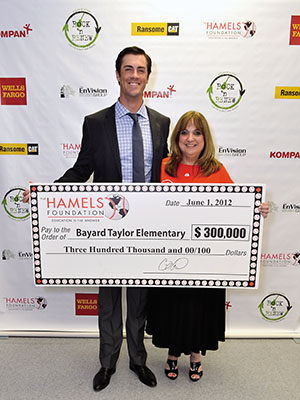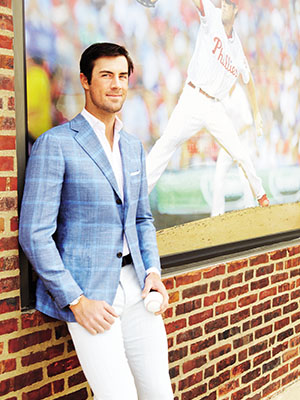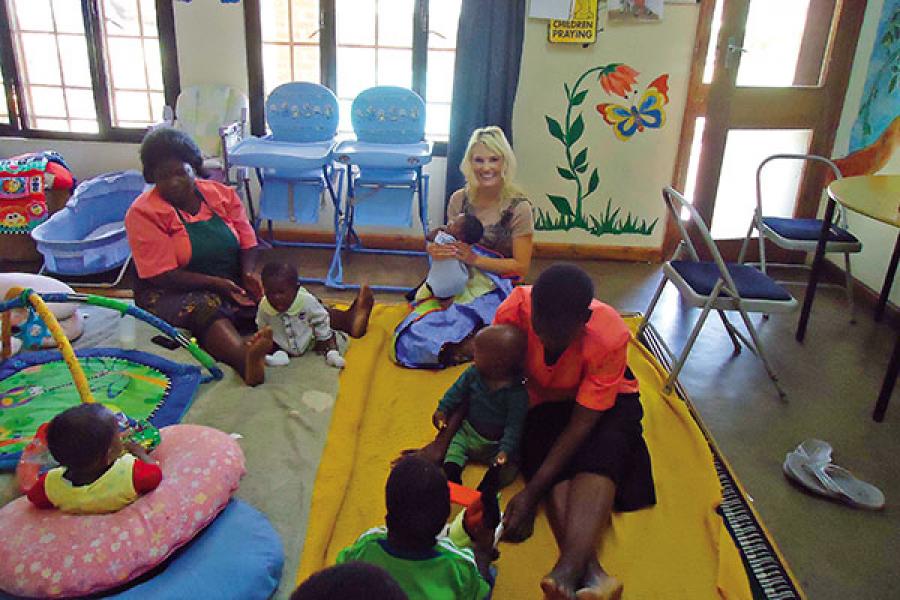
For Philadelphia pitcher Hamels, charity begins at home
Philadelphia Phillies pitcher Cole Hamels’ small foundation packs a powerful punch
On an early summer morning Cole Hamels sits in a bustling hotel lounge in midtown Manhattan, sipping orange juice from a bottle, wearing jeans and an untucked button-down shirt. The three-time All-Star and 2008 World Series MVP for the Philadelphia Phillies is pitching tonight against the New York Mets, across the river at Citi Field, yet not one hotel patron seems to notice him. Even his then manager, Charlie Manuel, walks right by him without a glance.
Perhaps it’s because the 29-year-old Hamels gives off the impression of a surfer dude who has been reluctantly dragged to New York City by his parents. But it also very much has to do with the fact that he doesn’t fit our popular notion of what a baseball player looks like. Hamels is tall (6’3”), yes, but he’s also very skinny. But from that slim frame he generates a surprising amount of power. The lefty’s fastball, which tops out at 95 mph or so, perfectly sets up his signature change-up, which, even with his uncharacteristic struggles this year (at press time, he was 5-13), has helped him to a lifetime 3.37 ERA and average of 14 wins a year in his eight seasons in the majors, all with the Phillies.
Off the field, Hamels has managed to pull off a similar feat with his philanthropy, which he has pursued with his wife, Heidi, a former Playboy Playmate and Survivor contestant. The Hamels Foundation, which funds childhood education programmes in Africa and in Philadelphia, is a tiny operation, with an annual budget of just under $1 million.
But because Hamels covers all of the foundation’s expenses, 100 percent of every dollar raised actually goes to its programmes, a rarity in the world of athlete-backed philanthropies designed more for buzz than impact.
Hamels started the foundation in 2009 after signing a three-year, $20.5 million contract with the Phillies. (In 2012, he was extended by six years for an additional $144 million.) “We just realised that we were pretty fortunate,” says Hamels.
But his contract wasn’t his only motivation. “Over the years we’d given money to other charities, hoping the money would do some good,” he says. Hamels was disappointed in the results. “We realised that not much of that money was going to the actual programmes. We thought we could do it better by being more efficient.”
Indeed, efficiency is not the hallmark of many athlete charities. A Boston Globe report from earlier this year listed a few of the more egregious examples. The charity of Los Angeles Dodgers pitcher Josh Beckett (then with the Red Sox) provided only 37 percent of its raised funds to actual programmes in 2007. Only 17 percent of funds raised by San Francisco 49ers’ Anquan Boldin for his foundation made it through to its causes in 2010. Many of the athlete charities analysed spent less than 65 percent of donated monies on actual programmes.
To the Hamelses staying small meant less (read: No) overhead and more effectiveness. “We’re never going to be the Red Cross, but that was never the goal,” says Heidi. “But we do want to be the best-run family foundation in the world.” Hamels kicked off the foundation with an initial $1 million donation. Additional funds are raised through an annual event hosted by the Hamelses called ‘Diamonds and Denim’, where Philadelphia sports figures, Playboy Playmates and local business honchos gather to donate money and listen to music acts like LeAnn Rimes, Martina McBride, John Legend and the band Lifehouse, which played the event this year.
The foundation’s first initiative was in Malawi. Why there? “We looked around, and it became very clear that this was one of the most needy places in the world,” says Hamels. Malawians face a life expectancy of just 53, and 11 percent of the population is infected with AIDS, one of the highest rates in the world, which has left the country with about 1 million orphans. Hamels decided education could help (he is the son of two educators).
Last year, the foundation broke ground on a school that will eventually have 1,000 students. Phase one of the construction comprise classrooms and teacher housing (teachers will live at the school since most face 10-mile walks from home). Next up for the school is a library and sports fields. The entire project will cost $3.5 million and is expected to be completed by 2016.

In all the Hamelses have given just over $1 million in science and music equipment, public address systems and playgrounds to Philly schools. The grants include $300,000 to the Bayard Taylor School for a new state-of-the- art playground last year. “It is the most thrilling thing I’ve been a part of as an educator,” says Debra Drossner, the school’s principal. Says Hamels: “I’m not usually a very emotional person, but when we walk around these schools and see the joy in the faces, it hits home.”
The Hamelses have extended their goodwill to their own household. Last year, they adopted a little girl from an orphanage in Ethiopia who had been abandoned on the playground at 2 days old. She joined the Hamelses’ two toddler-aged boys.
(This story appears in the 13 December, 2013 issue of Forbes India. To visit our Archives, click here.)
















